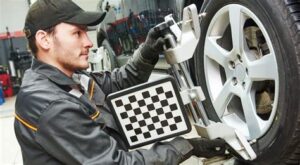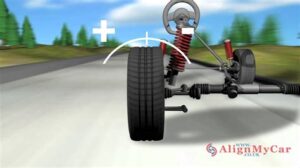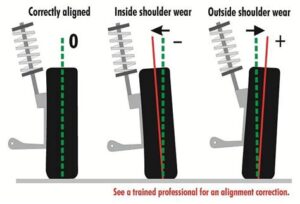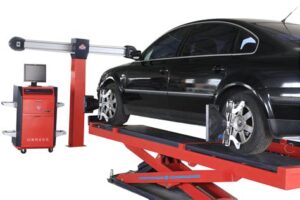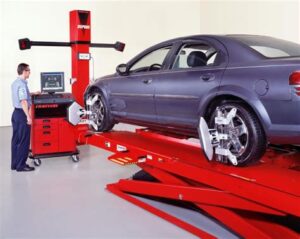In today’s fast-paced world, ensuring your vehicle operates smoothly is essential not only for performance but also for safety. One crucial aspect that many drivers overlook is proper car wheel alignment. A high-quality car wheel alignment machine is vital for maintaining the correct positioning of your wheels, optimizing tire lifespan, and enhancing overall driving experience. This article will delve into the fundamental principles of wheel alignment, guide you in selecting the right alignment machine for your needs, and provide a comprehensive, step-by-step process for achieving optimal alignment. Additionally, we will explore the significant impact of proper alignment on tire longevity and discuss common issues that may indicate misaligned wheels. With this knowledge, you’ll be empowered to make informed decisions for your vehicle’s maintenance. Get ready to enhance your driving safety, efficiency, and comfort!
Understanding Car Wheel Alignment Principles
Car wheel alignment is a critical aspect of vehicle maintenance that ensures all wheels are positioned correctly with respect to each other and the road. Proper alignment improves handling, increases safety, and enhances the lifespan of tires. Here are the key principles behind car wheel alignment:
1. Camber: This refers to the angle of the wheel in relation to the vertical axis. A positive camber means the top of the wheel is tilted away from the vehicle, while a negative camber indicates it is tilted inwards. Ideally, the camber should be aligned as per manufacturer specifications to ensure even tire wear.
2. Caster: The caster angle is the angle of the steering pivot. It affects steering stability and how the wheels return to the center after turning. A proper caster angle contributes significantly to the handling characteristics of the vehicle.
3. Toe: This is the angle at which the wheels point in relation to the centerline of the vehicle. If the front of the wheels is closer together than the back, it is called toe-in, while if the back is closer, it is referred to as toe-out. Correct toe alignment ensures that tires contact the road evenly, reducing wear and improving fuel efficiency.
Maintaining the right camber, caster, and toe angles is vital for optimal tire performance and overall vehicle safety. A car wheel alignment check is essential whenever you notice uneven tire wear or experience changes in handling. Regular assessments help you catch misalignments early, ensuring your vehicle runs smoothly and safely.
Selecting the Right Car Wheel Alignment Machine
Choosing the appropriate car wheel alignment machine is crucial for ensuring accurate alignments and boosting the efficiency of your service center. With various types and features available, it’s important to consider several factors that meet your specific needs.
Here are the key considerations when selecting the right machine:
Investing in the right car wheel alignment machine not only ensures the precision of alignments but also enhances customer satisfaction, thereby driving your business’s success. Prioritize your options carefully to make the best choice tailored to your operational needs.
Step-by-Step Process of Car Wheel Alignment
Achieving proper car wheel alignment is essential for maintaining vehicle performance and safety. Here’s a step-by-step guide on how to perform car wheel alignment accurately:
- Initial Inspection: Begin by inspecting the vehicle’s suspension components and tires. Check for any signs of wear or damage that could affect the alignment process.
- Tire Pressure Check: Ensure that all tires are inflated to the recommended pressure. Uneven tire pressure can lead to incorrect alignment readings.
- Position the Vehicle: Use a level and flat surface to position the vehicle correctly. It’s crucial to ensure that the vehicle is on a level ground before beginning the alignment process.
- Attach Alignment Equipment: Using a car wheel alignment machine, attach the alignment heads or sensors to the wheels of the vehicle. Follow the manufacturer’s instructions for proper setup.
- Measure Alignment Angles: Begin measuring the alignment angles, including camber, caster, and toe. Most modern machines will provide a readout of these angles for assessment.
- Adjustments: Based on the measurements obtained, make the necessary adjustments to the suspension components to align the wheels correctly. This may involve altering tie rods or camber bolts.
- Recheck Angles: After adjustments, measure the alignment angles again to ensure they fall within the manufacturer’s specifications. It’s vital to confirm that the adjustments have rectified the alignment.
- Test Drive: Finally, take the vehicle for a test drive to ensure that it drives straight and the steering wheel is centered. This helps confirm that the alignment has been successfully completed.
By diligently following these steps, you can ensure proper car wheel alignment, which will contribute to better handling, increased tire lifespan, and improved fuel efficiency.
The Impact of Proper Alignment on Tire Lifespan
Maintaining proper alignment of your vehicle’s wheels is crucial for extending the lifespan of your tires. When the car wheel alignment is correct, tires wear evenly, which not only enhances performance but also maximizes the durability of the tires.
Improper alignment can lead to uneven tire wear, resulting in a shorter lifespan and the need for premature replacement. For instance, if the wheels are misaligned, you may notice that the inner or outer edges of the tire are wearing down faster than the center, creating an imbalance that affects both safety and driving comfort.
Moreover, correct alignment contributes to better fuel efficiency. Misaligned wheels can increase rolling resistance, causing your engine to work harder and consume more fuel. By ensuring that your car wheel alignment is properly adjusted, you help maintain optimal fuel efficiency, which can lead to significant savings over time.
Regular checks and adjustments of your car wheel alignment not only promote tire longevity but also improve overall vehicle performance. This simple maintenance task can save you money and extend the life of your tires, ensuring a smoother and safer driving experience.
Common Issues Indicated by Misaligned Car Wheels
Misalignment of your car wheel can lead to a variety of issues that not only affect the performance of your vehicle but can also pose safety risks. Being aware of these common problems can help you identify when your wheels are not aligned properly:
- Uneven Tire Wear: If your car wheel alignment is off, it can lead to tires wearing down unevenly. This not only shortens the lifespan of your tires but may also require premature replacements.
- Steering Wheel Off-Center: A clear indicator of wheel misalignment is when the steering wheel is not centered while driving straight. This can cause discomfort and reduced control over the vehicle.
- Pulling to One Side: If your car consistently drifts to the left or right, it could signify that your wheels are misaligned. This not only makes driving harder but can be unsafe as well.
- Increased Road Noise: Misaligned wheels can create abnormal tire wear patterns that contribute to increased noise while driving. If you notice excessive noise, it’s worth checking your alignment.
- Vibration in the Steering Wheel: If you feel vibrations in your steering wheel during a drive, it may be a sign of alignment issues among other mechanical problems.
Addressing these common issues promptly by visiting a car service center for a wheel alignment can save you money in the long run and ensure a safer driving experience. Regular checks on your car wheel alignment can maximize performance and enhance your vehicle’s handling.
Frequently Asked Questions
What is a car wheel alignment machine?
A car wheel alignment machine is a specialized device used to measure and adjust the angles of the wheels on a vehicle to ensure they are properly aligned with each other and the road.
Why is wheel alignment important for my vehicle?
Proper wheel alignment is important for improving vehicle handling, extending tire life, enhancing fuel efficiency, and ensuring a comfortable ride.
How often should I have my wheel alignment checked?
It’s recommended to check wheel alignment every 6,000 miles or as specified by your vehicle’s manufacturer, or whenever you notice uneven tire wear or changes in handling.
What are the symptoms of misalignment?
Symptoms of misalignment can include uneven tire wear, the steering wheel being off-center, pulling to one side, and a vibrating steering wheel.
Can I perform wheel alignment myself?
While some basic adjustments can be made on your own, professional wheel alignment typically requires specialized equipment and expertise for accurate results.
What types of wheel alignment machines are available?
There are several types of wheel alignment machines, including 2D and 3D alignment systems, which use cameras and sensors to provide precise measurements and adjustments.
What is the average cost of a wheel alignment service?
The average cost of a wheel alignment service can vary, typically ranging from $50 to $100, depending on the vehicle type and the service provider.
